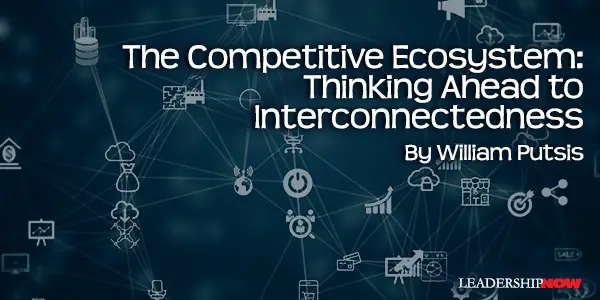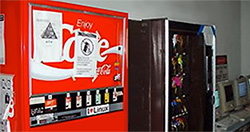 |
 |
03.15.21

The Competitive Ecosystem: Thinking Ahead to Interconnectedness
IN 1982, then graduate students at Carnegie Mellon, Michael Kazar and David Nichols, devised an early IoT (Internet of Things) experiment. Recalls Kazar, “There was a Coke machine on the third floor of this eight-story building, and people didn’t like the fact that they would go down all the way to the third floor and discover that the Coke machine was empty. Someone said, ‘Hey, why don’t we set it up so the Coke machine is on the Internet?’”  In many ways, this early prototype illustrates what IoT is all about — in principle, the Coke machine could automatically reorder supply when stock was running low or dynamically change prices, depending upon stock or demand. Coke suppliers would know ahead of time that supply needed to be increased because the demand at vending machines was increasing. Indeed, the interconnected vending machine had the potential to impact bottlers, distribution (for firms supplying vending machines), repair and maintenance companies that service the vending machines, and even the demand for coffee in the building’s cafeteria that might benefit from vending machine stock-outs. And the list goes on. One simple idea, connecting vending machines to the internet, had the potential to affect multiple industries. This type of interconnected ecosystem makes today’s economy so unique. One action affects multiple value chains across multiple, high- and low-tech industries alike. From internet-enabled vending machines in 1982 to traffic lights in 2018 In December 2018, Larry Page, the cofounder of Google and CEO of Google’s parent company, Alphabet, attended a gathering of about 200 of the country’s top CEOs in New York. In front of this group, he was asked what he would do with the $86 billion in cash that Alphabet had at the time (mostly overseas) when tax policy changed so that he was able to bring that money back to the United States with more favorable tax treatment. His answer was surprising yet telling: “traffic lights.” In fact, two other times in the next 10 minutes, he was asked about topics that had absolutely nothing to do with traffic lights and his answer each time was “traffic lights.” Page went on to explain that he sits at his desk in Mountain View, California, most mornings and watches his employees sitting at a traffic light, waiting to come to work. Oftentimes, no traffic is moving in any direction. He sees this as a waste of time that reduces productivity and impacts the environment from engines idling for minutes at a time. However, with his answer, he wasn’t actually talking about traffic lights. He was thinking many steps ahead and looking into a future when cars are automated and start talking to each other. Cars will slow, not stop, for other cars automatically. Accidents will be avoided and traffic will flow smoothly and unimpeded. We won’t need traffic lights at all. In order for this to happen, however, an ecosystem must be built. Cars need to be increasingly autonomous and inter-vehicle communications must be predictable and secure. The elimination of traffic lights would be the result of successful interconnected vehicles, not the objective of interconnecting them. It’s about building all of the components of the ecosystem so that we won’t need traffic lights. In order to fully understand the ramifications, think to the demands on our infrastructure. For example, there are constant and never-ending calls for more roads to alleviate congestion in urban and suburban areas. However, in a world where most traffic is autonomous and interconnected, we would actually have an over-abundance of roads. The impact of autonomous, interconnected vehicles extends well beyond automobile (and related) production to impact road construction-related firms and industries — from asphalt and paving companies to heavy equipment to laborers to local municipal and federal highway budgets. All of this requires thinking many steps ahead. Indeed, Larry Page and Sergey Brin, the two cofounders of Google, are the only two individuals publicly talking about strategic control points in interconnected markets. They clearly get it. All of this suggests three things to think about beyond products to platforms and beyond platforms to ecosystems: 1. Think ahead. The issue with traffic lights isn’t about traffic lights — it’s actually about no longer having a need for traffic lights. The interconnected Coke vending machine was about not needing to go down several floors in the building to find out about the stock levels. 2. Know the underlying needs. Saving time is an underlying need in both stories. 3. Think “right to left,” not “left to right,” and avoid incrementalism. Think where you want to be (the “right” end of a timeline) and work back to today (the “left” side of a timeline). Then, ask what you can do today (connect a vending machine, eliminate traffic lights) to get to the vision you have at the end of that timeline.  
Posted by Michael McKinney at 12:47 AM
|
BUILD YOUR KNOWLEDGE
 

How to Do Your Start-Up Right STRAIGHT TALK FOR START-UPS 
Grow Your Leadership Skills NEW AND UPCOMING LEADERSHIP BOOKS 
Leadership Minute BITE-SIZE CONCEPTS YOU CAN CHEW ON 
Classic Leadership Books BOOKS TO READ BEFORE YOU LEAD |